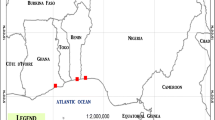Abstract
The environmental quality and toxicity of soil from some selected informal e-waste sites in West Africa was assessed on PLHC-1 liver cells. In addition, toxicity mechanisms such as apoptosis, necrosis and necroptosis were analysed in order to determine the effect of the actual chemical mixture present in the e-waste soil matrix. The investigation revealed that although e-waste soil extracts (polar and non-polar) and elutriates were significantly cytotoxic at the tested concentration (16 mg soil EQ/ml), PLHC-1 cell viability was not reduced below 50%. The non-polar extracts were more toxic compared to polar extracts and elutriates. The cytotoxic potency of soil from the informal e-waste-recycling sites ranged in this order: Alaba > Godome-Kouhounou > Agbogblosie. The study revealed that all e-waste soil extracts and elutriates induced significant (P < 0.01) PLHC-1 cell death by apoptosis and necrosis; however, cell death by apoptosis was higher compared to that by necrosis. The results indicated that except for non-polar extracts (N4, B4 and G4) from open burning areas that induced significant (P < 0.01) PLHC-1 cell death by necroptosis, other extracts and elutriates could not cause cell death by necroptosis. The study has demonstrated that soils from the Alaba e-waste site in Lagos could be more toxic than soils from Godome-Kouhounou (Cotonou) and Agbogblosie (Accra) e-waste sites and further highlighted open burning as an informal e-waste-handling method with greater negative impact on soil quality in the e-waste sites. The study emphasizes the urgent need for regulatory agencies to introduce regular residue-monitoring programmes in order to forestall the adverse effects of soil pollution episodes in the e-waste sites.







Similar content being viewed by others
Data availability
The generated datasets analysed in this study are not publicly available but are available from the corresponding author on reasonable request.
References
Adediran, Y. A., & Abdulkarim, A. (2012). Challenges of electronic waste management in Nigeria. International Journal of Advances in Engineering & Technology, 4(1), 640.
Aslantürk, Ö. S. (2018). In vitro cytotoxicity and cell viability assays: Principles, advantages, and disadvantages (Vol. 2, p. 64). In Tech.
Blanco, M., Pérez-Albaladejo, E., Piña, B., Kušpilić, G., Milun, V., Lille-Langøy, R., Karlsen, O. A., Goksøyr, A., & Porte, C. (2018). Assessing the environmental quality of sediments from Split coastal area (Croatia) with a battery of cell-based bioassays. Science of the Total Environment, 624, 1640–1648.
Bols, N. C., Dayeh, V. R., Lee, L. E. J., & Schirmer, K. (2005). Use of fish cell lines in the toxicology and ecotoxicology of fish. Piscine cell lines in environmental toxicology. Biochemistry and Molecular Biology of Fishes, 6, 43–84.
Brigden, K., Labunska, I., Santillo, D., & Allsopp, M. (2005). Recycling of electronic wastes in China and India: Workplace and environmental contamination. Greenpeace Research Laboratories Technical Note 09/2005, Publ. Greenpeace International, 56 pp. (+ 47 pp. appendices). 10/2
Brigden, K., Labunska, I., Santillo, D., & Johnston, P. (2008). Chemical contamination at e-waste recycling and disposal sites in Accra and Korforidua. Greenpeace, Ghana.
Chan, J. K. Y., & Wong, M. H. (2013). A review of environmental fate, body burdens, and human health risk assessment of PCDD/Fs at two typical electronic waste recycling sites in China. Science of the Total Environment, 463, 1111–1123.
Chen, A., Dietrich, K. N., Huo, X., & Ho, S. M. (2011). Developmental neurotoxicants in e-waste: An emerging health concern. Environmental Health Perspectives, 119(4), 431–438.
Choi, M. K., Kim, B. H., Chung, Y. Y., & Han, M. S. (2002). Cadmium-induced apoptosis in h9c2, a7r5, and c6-glial cell. Bulletin of Environmental Contamination and Toxicology, 69(3), 335–341.
Dong, S., Shen, H. M., & Ong, C. N. (2001). Cadmium-induced apoptosis and phenotypic changes in mouse thymocytes. In Molecular mechanisms of metal toxicity and carcinogenesis (pp. 11–20). Springer, Boston, MA.
Duffus, J. H. (2002). “Heavy metals”—A meaningless term? (IUPAC Technical Report). Pure and Applied Chemistry, 74(5), 793–807.
Ekwall, B. (1983). Correlation between cytotoxicity in vitro and LD50-values. Acta Pharmacologica Et Toxicologica, 52, 80–99.
El Azzouzi, B., Tsangaris, G. T., Pellegrini, O., Manuel, Y., Benveniste, J., & Thomas, Y. (1994). Cadmium induced apoptosis in a human T cell line. Toxicology, 88(1–3), 127–139.
Eze C. T, Michelangeli, F., & Otitoloju, A. A. (2019). In vitro cyto-toxic assessment of heavy metals and their binary mixtures on Mast cell-like, Rat Basophilic Leukemia (RBL-2H3) Cells. Chemosphere, 223: 686 -693.https://doi.org/10.1016/j.chemosphere.2019.02.0350045-6535/© 2019.
Eze, C. T., Michelangeli, F., Otitoloju, A. A., Eze, O. O., Omodele, I., Ogbuene, E. B., & Ogunwole, G. A. (2020). Occurrence of chemical pollutants in major e-waste sites in West Africa and usefulness of cytotoxicity and induction of ethoxyresorufin-O-deethylase (EROD) in determining the effects of some detected brominated flame retardants and e-waste soil-derived extracts. Environmental Science & Pollution Research, 28(9), 10832–10846. https://doi.org/10.1007/s11356-020-11155-7
Fernandes, D., Pujol, S., Pérez-Albaladejo, E., Tauler, R., Bebianno, M. J., & Porte, C. (2014). Characterization of the environmental quality of sediments from two estuarine systems based on different in-vitro bioassays. Marine Environmental Research, 96, 127–135.
Fuente, H. D. L., Portales-Perez, D., Baranda, L., Diaz-Barriga, F., Saavedra-Alanis, V., Layseca, E., & González-Amaro, R. (2002). Effect of arsenic, cadmium and lead on the induction of apoptosis of normal human mononuclear cells. Clinical & Experimental Immunology, 129(1), 69–77.
Gennari, A., Cortese, E., Boveri, M., Casado, J., & Prieto, P. (2003). Sensitive endpoints for evaluating cadmium-induced acute toxicity in LLC-PK1 cells. Toxicology, 183(1–3), 211–220.
Habeebu, S. S., Liu, J., & Klaassen, C. D. (1998). Cadmium-induced apoptosis in mouse liver. Toxicology and Applied Pharmacology, 149(2), 203–209.
Hendriks, H. S., Meijer, M., Muilwijk, M., van den Berg, M., & Westerink, R. H. (2014). A comparison of the in vitro cyto-and neurotoxicity of brominated and halogen-free flame retardants: Prioritization in search for safe(r) alternatives. Archives of Toxicology, 88(4), 857–869.
Kamer, I., & Rinkevich, B. (2002). In vitro application of the comet assay for aquatic genotoxicity: Considering a primary culture versus a cell line. Toxicology in Vitro, 16(2), 177–184.
Karri, V., Kumar, V., Ramos, D., Oliveira, E., & Schuhmacher, M. (2018). An in vitro cytotoxic approach to assess the toxicity of heavy metals and their binary mixtures on hippocampal HT-22 cell line. Toxicology Letters, 282, 25–36.
Kemi, V., Numeri, N. S. J. N., & Simulacijo, N. (2011). The influence of the chemical composition of steels on the numerical simulation of a continuously cast slab. Materiali in Tehnologije, 45(4), 363–367.
Kitamura, S., Kato, T., Iida, M., Jinno, N., Suzuki, T., Ohta, S., Fujimoto, N., Hanada, H., Kashiwagi, K., & Kashiwagi, A. (2005). Anti-thyroid hormonal activity of tetrabromobisphenol A, a flame retardant, and related compounds: Affinity to the mammalian thyroid hormone receptor, and effect on tadpole metamorphosis. Life Sciences, 76(14), 1589–1601.
Kitamura, S., Suzuki, T., Sanoh, S., Kohta, R., Jinno, N., Sugihara, K., Yoshihara, S. I., Fujimoto, N., Watanabe, H., & Ohta, S. (2005). Comparative study of the endocrine-disrupting activity of bisphenol A and 19 related compounds. Toxicological Sciences, 84(2), 249–259.
Li, Y., Zhang, W., Dai, Y., Su, X., Xiao, Y., Wu, D., Sun, F., Mei, R., Chen, J. & Lin, H. (2021). Effective partial denitrification of biological effluent of landfill leachate for Anammox process: Start-up, influencing factors and stable operation. Science of The Total Environment, 150975.
Lundgren, K. (2012). The global impact of e-waste: Addressing the challenge. International Labour Organization. Available at: http://www.ilo.org/wcmsp5/groups/public/—ed_dialogue/—sector/documents/publication/wcms_196105.pdf.
Nakajima, A., Saigusa, D., Tetsu, N., Yamakuni, T., Tomioka, Y., & Hishinuma, T. (2009). Neurobehavioral effects of tetrabromobisphenol A, a brominated flame retardant, in mice. Toxicology Letters, 189(1), 78–83.
Natoli, L., Luci, G., Mennillo, E., Adeogun, A. O., & Arukwe, A. (2019). Assessing the effects of Awba dam sediment (Nigeria) on the steroidogenesis of H295R cells using different extraction methods. Science of the Total Environment, 650, 121–131.
Nnorom, I. C., Ohakwe, J., & Osibanjo, O. (2009). Survey of willingness of residents to participate in electronic waste recycling in Nigeria–A case study of mobile phone recycling. Journal of Cleaner Production, 17(18), 1629–1637.
Nnorom, I. C., & Osibanjo, O. (2008). Overview of electronic waste (e-waste) management practices and legislations, and their poor applications in the developing countries. Resources, Conservation and Recycling, 52(6), 843–858.
Omole, D. O., Tenebe, I. T., Emenike, P. C., Umoh, A. S., & Badejo, A. A. (2015). Causes, impact and management of electronic wastes: Case study of some Nigerian communities. ARPN Journal of Engineering and Applied Sciences, 10(18), 7876–7876.
Orrenius, S., Nicotera, P., & Zhivotovsky, B. (2011). Cell death mechanisms and their implications in toxicology. Toxicological Sciences, 119(1), 3–19.
Perkins, D. N., Drisse, M. N. B., Nxele, T., & Sly, P. D. (2014). E-waste: A global hazard. Annals of Global Health, 80(4), 286–295.
Purchase, D., Abbasi, G., Bisschop, L., Chatterjee, D., Ekberg, C., Ermolin, M., Fedotov, P., Garelick, H., Isimekhai, K., Kandile, G. N., Lundstrom, M., Matharu, A., Miller, W. B., Pineda, A., Popoola, E. O., Retegan, T., Ruedel, H., Serpe, A., Sheva, Y., … Wong, H. M. (2020). Global occurrence, chemical properties, and ecological impacts of e-wastes (IUPAC Technical Report). Pure and Applied Chemistry, 92(11), 1733–1767.
Reistad, T., Mariussen, E., & Fonnum, F. (2005). The effect of a brominated flame retardant, tetrabromobisphenol-A, on free radical formation in human neutrophil granulocytes: The involvement of the MAP kinase pathway and protein kinase C. Toxicological Sciences, 83(1), 89–100.
Reistad, T., Mariussen, E., Ring, A., & Fonnum, F. (2007). In vitro toxicity of tetrabromobisphenol-A on cerebellar granule cells: Cell death, free radical formation, calcium influx and extracellular glutamate. Toxicological Sciences, 96(2), 268–278.
Robinson, B. H. (2009). E-waste: An assessment of global production and environmental impacts. Science of the Total Environment, 408(2), 183–191.
Su, X., Li, S., Xie, M., Tao, L., Zhou, Y., Xiao, Y., Y., Lin, H., Chen, J., & Sun, F. (2021). Enhancement of polychlorinated biphenyl biodegradation by resuscitation promoting factor (Rpf) and Rpf-responsive bacterial community. Chemosphere, 263, 128283.
Tansel, B. (2017). From electronic consumer products to e-wastes: Global outlook, waste quantities, recycling challenges. Environment International, 98, 35–45.
Xie, M., Xu, L., Zhang, R., Zhou, Y., Xiao, Y., Su, X., Shen, C., Sun, F., Hashmi, M.Z., Lin, H., & Chen, J. (2021). Viable but nonculturable state of yeast Candida sp. strain LN1 induced by high phenol concentrations. Applied and environmental microbiology, 87(18), e01110–21.
Acknowledgements
We acknowledge Professor Augustine Arukwe of the Department of Biological Sciences, Norwegian University of Science and Technology, Trondheim, for providing the analytical technique, laboratory space and consumables for the e-waste soil extractions.
Author information
Authors and Affiliations
Contributions
Chukwuebuka ThankGod Eze and Adebayo Akeem Otitoloju designed the study. Chukwuebuka ThankGod Eze, Adebayo Akeem Otitoloju and Obianuju Oluchukwu Eze performed the research. Chukwuebuka ThankGod Eze, Tochukwu Ernest Ugochukwu, Obianuju Oluchukwu Eze, Nnamdi Henry Amaeze, Emeka Bright Ogbuene and Adebayo Akeem Otitoloju analysed the data. Chukwuebuka ThankGod Eze, Adebayo Akeem Otitoloju and Obianuju Oluchukwu Eze prepared the manuscript. Tochukwu Ernest Ugochukwu, Nnamdi Henry Amaeze and Emeka Bright Ogbuene contributed in performing the research and writing of manuscript.
Corresponding author
Ethics declarations
Ethics approval
Not applicable.
Consent for publication
All authors read and approved the final manuscript.
Competing interests
The authors declare no competing interests.
Additional information
Publisher's Note
Springer Nature remains neutral with regard to jurisdictional claims in published maps and institutional affiliations.
Rights and permissions
About this article
Cite this article
Eze, C.T., Eze, O.O., Ugochukwu, T.E. et al. In vitro cytotoxic assessment of e-waste-related chemical pollution in impacted soil matrix. Environ Monit Assess 194, 209 (2022). https://doi.org/10.1007/s10661-021-09717-4
Received:
Accepted:
Published:
DOI: https://doi.org/10.1007/s10661-021-09717-4




